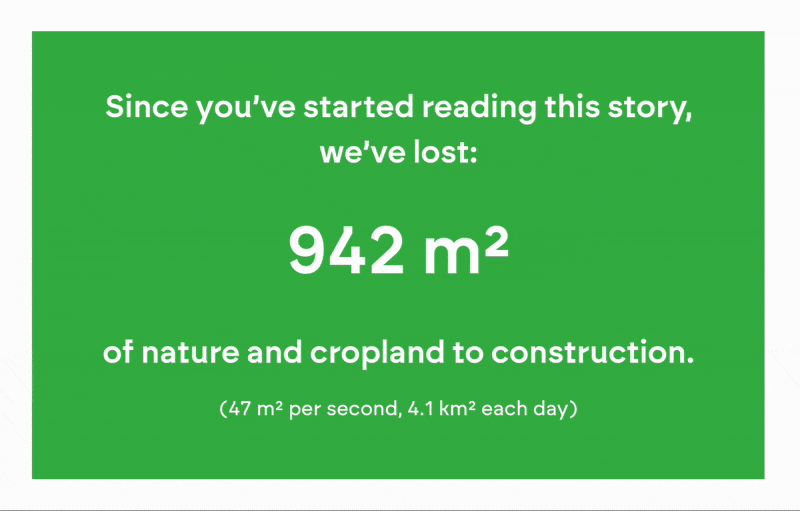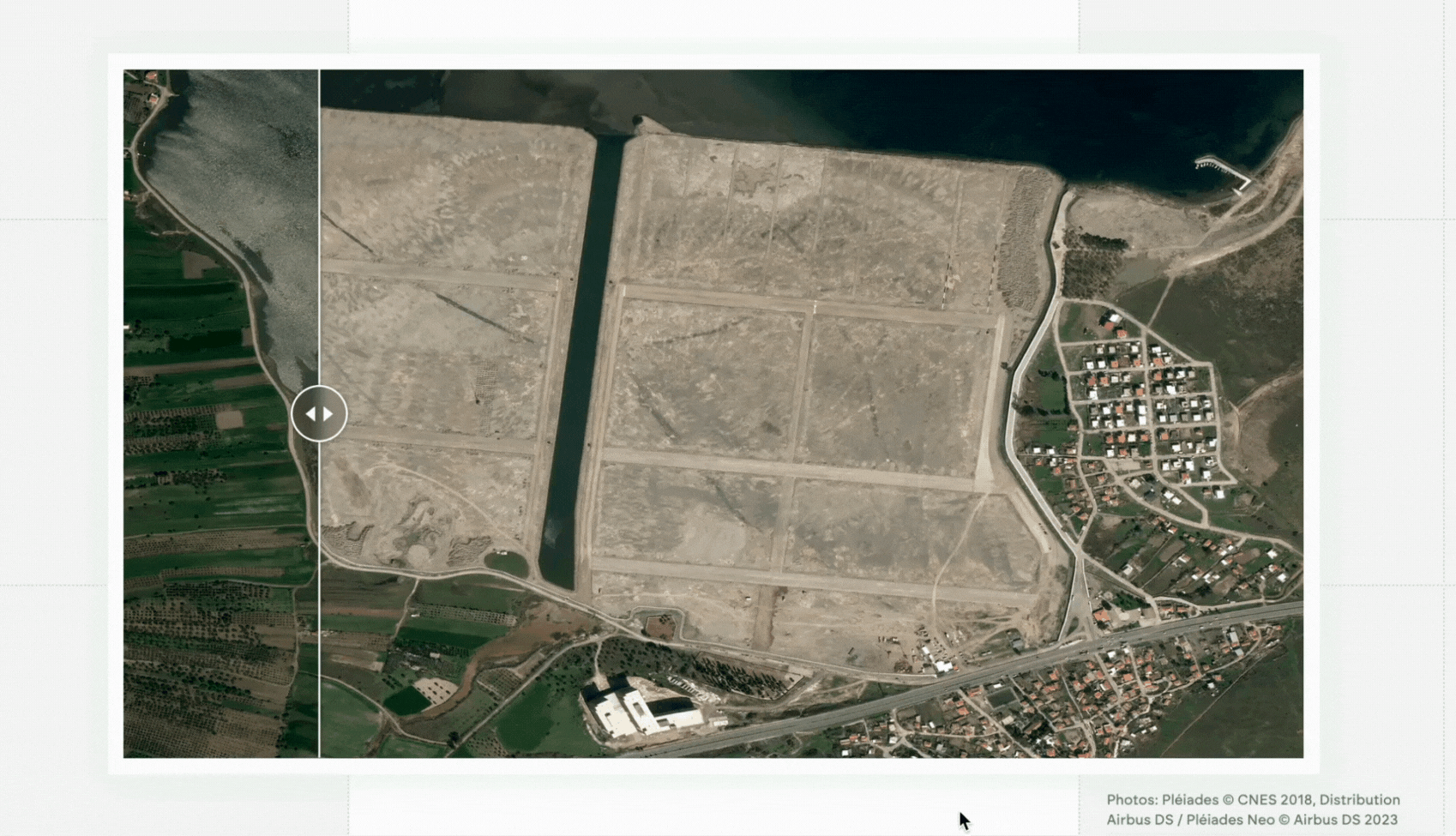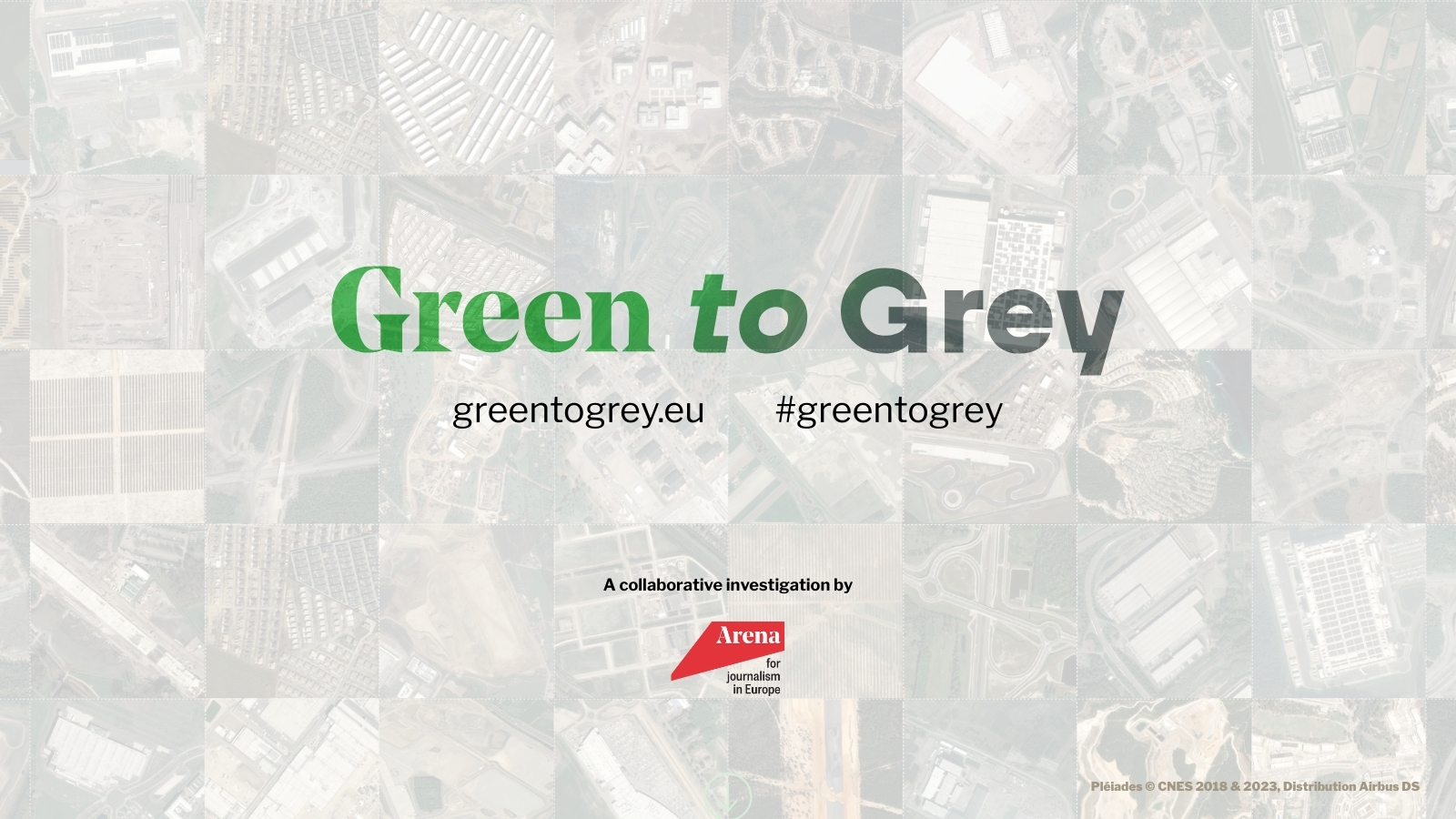Our collaboration with 11 newsrooms shows Europe’s undeveloped land is disappearing up to 1.5 times faster than previously thought, equivalent to 600 football pitches per day.
In the first investigation of its kind, 41 journalists and scientists from 11 countries have come together for the Green to Grey project, to reveal the scale of Europe’s nature and cropland loss.
We’re proud not only to have led and published another major cross-border, collaborative investigation, but also to share with you exactly how Arena puts a massive project like this together. Read on to learn about:
- How the project developed
- Our headline findings
- How experts, environmentalists and EU lawmakers have responded
- The team behind Green to Grey
- What’s next, and how you can be involved
How the project developed
Arena initiated this project in partnership with the Norwegian Broadcasting Corporation, NRK, scaling up an original investigation into land loss across Norway by journalists Mads Nyborg Støstad, Su Thet Mon and Ruben Solvang: Norway in red, white and grey. This work, produced alongside the Norwegian Institute for Nature Research (NINA), “caused an uproar” according to Støstad, who also worked on Green to Grey.
It was shortlisted in the innovation category for the European Press Prize, and certainly impressed the Arena team. We invited NRK and NINA to a meeting at the 2024 Climate Arena conference, alongside other national media teams, to discuss the methodology and potential for scaling-up. Everybody agreed: the devastating scale of Norway’s nature loss revealed a strong need to find out whether this was replicated across all of Europe.
“Ecosystems don’t follow national borders, we’re all part of the same continent. And [at NRK] we figured, this type of visual documentation of bit-by-bit area loss could make an impact in other countries as well”, said Støstad.
The cross-border team we assembled to expand the investigation Europe-wide became 41-strong, from 11 national newsrooms plus Norway’s research institute, NINA: Datadista (Spain), De Standaard (Belgium), Die Zeit (Germany), Facta (Italy), Gazeta Wyborcza (Poland), Le Monde (France), Long Play (Finland), NRK (Norway), Reporters United (Greece), The Black Sea (Turkey), and The Guardian (UK).
While all the journalists were digging into their national investigations, Arena’s own journalists, data specialists and designers worked on ‘the EU story’. This top-level investigation functions not only as a landing page that anchors the project in one place, but also outlines the findings for the EU as a whole, weaving together the different contexts between national and continent-wide findings.
By working together as one project team, and hosting all the individual stories on the Green to Grey landing page, we can not only promote each others’ important work, but also demonstrate the massive scope of the investigation – and of the problem of Europe’s staggering rate of nature and cropland loss.

The project brought together a scale-up of the original method of combining satellite imagery, artificial intelligence, and on-the-ground reporting, revealing for the first time the true extent of land loss across Europe (read more about our methodology in full here.)
But this is not the end of the project – find out how about the app our project partners at NINA have launched, to continue the work, at the end of this piece.
Our headline findings
Our investigation found that every year, Europe loses 1,500 km² to construction. Between 2018 and 2023, we lost approximately 9,000km² – an area the size of Cyprus.
This is close to 30km² destroyed every week, the equivalent of 600 football pitches every single day (1km² is equivalent to 1 million m².)
Nature, such as forests, grasslands and wetlands, accounts for the majority of these losses, at about 900km² a year. But agricultural land is not spared – it accounts for 600km² of losses every year, with grave consequences for food security and health. Our results show that undeveloped land in Europe is disappearing up to one and a half times faster than previously thought by EEA officials.
We found that the main drivers of land loss across Europe are housing and road building, but we also found many instances of construction that serve only a minority or that are not built based on public need, such as luxury tourism sites. In one example, a vibrant wetland in Turkey was filled with concrete to create a luxury yacht repair facility.

In addition, more than 150,000 constructions, over 70 a day, encroached on protected areas. Some of these constructions were allowed by an area’s protection status or received a permit from authorities, while others could have been illegally built.
We found that over and above nature and biodiversity loss, a majority of these constructions are likely to worsen the effects of climate change. Four of every five instances of construction occurred within populated areas already transformed by human activities. This not only further fragments the little nature left in Europe and threatens areas important for recreation, it can also affect our ability to mitigate floods and extreme heat.
How experts, environmentalists and EU lawmakers have responded
We approached a number of researchers, academics and lawmakers with our findings. Peter Verburg, professor in Environmental spatial analysis at the University of Amsterdam called Green to Grey “a strong showcase[…] that everybody should be aware of.”
“This is dramatic,” said Gunnar Austrheim, professor at NTNU in Trondheim, “especially considering that just a couple of years ago, the EU introduced vigorous environmental policies, and now we’re witnessing setbacks.”
Lena Schilling, an MEP in the Green/European Free Alliance group, says “For years, the EU has promised to lead on climate and nature protection, but what this investigation shows is that we are literally cementing over our own future.”
The team behind Green to Grey
Arena’s Climate Network co-ordinator Zeynep Şentek, and Arena Networks co-ordinator Hazel Sheffield managed the project. Arena project manager Jelena Prtorić and data co-ordinator Léopold Salzenstein led the work of investigating, gathering and publishing data. Our tech co-ordinator Benedikt Hebeisen built the website alongside freelance designers at gegenfeuer.net.
We worked with journalists from 11 national newsrooms, to publish stories and findings specific to their countries:
- Ana Tudela and Antonio Delgado of Datadista
- Ine Renson, Simon Demeulemeester and Dries De Smet of De Standaard
- Claudia Vallentin and Karsten Polke-Majewski of Die Zeit
- Elisabetta Tola, Benedetta Pagni and Marco Boscolo of Facta
- Dominik Uhlig, Danuta Pawlowska, Ewa Tomkowska and Aleksander Gurgul of Gazeta Wyborcza
- Raphaelle Aubert, Romain Imbach and Elsa Delmas of Le Monde
- Hanna Nikkanen, Lotta Närhi and Tuomas Pulsa of Long Play
- Anne Linn Kumano-Ensby, Mads Nyborg Støstad and Ruben Solvang of NRK
- Eurydice Bersi, Dafni Karavola and Ioanna Petsiou of Reporters United
- Craig Shaw, Cemre Demircioğlu, Vedat Öruç and Özge Sebzeci of The Black Sea
- and Pamela Duncan, Zeke Hunter Green, Bibi van der Zee, Sandra Laville and Tural Ahmedzade of The Guardian
The investigation had a unique data methodology, developed by Zander Venter and Bálint Czúcz from the Norwegian Institute for Nature Research (NINA). NINA’s novel methodology for measuring nature loss was refined for the project, and is now developed further: they’ve launched a citizen science project to continue this work, that you can be a part of.
What’s next, and how you can be involved
Our scientific partners at NINA have launched the Nature Loss Detector, a cutting-edge AI model that uses satellite imagery to detect changes in nature loss.
But, NINA says, “even the smartest AI needs a great teacher. That’s where you come in.”
Some changes in nature loss are too small-scale to be detected by usual methods. So, NINA are asking people around the world to join their work on the Nature Loss Detector app.
The app shows you real satellite images from a specific location, and asks you to decide whether the habitat has been lost or not by comparing different time points. “No experience is needed—just keen eyes”.
We’re not only pleased to have been able to take this project from national to continent-wide impact, but equally so that NINA will scale it up once again – this time, globally.
Please do try out the app, and let us know what you found at media@journalismarena.eu
Find more examples of major Europe-wide investigations co-ordinated or supported by Arena’s at the Forever Pollution Project and Under the Surface.
